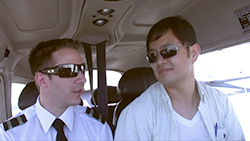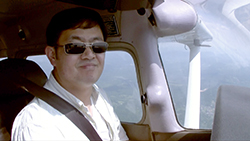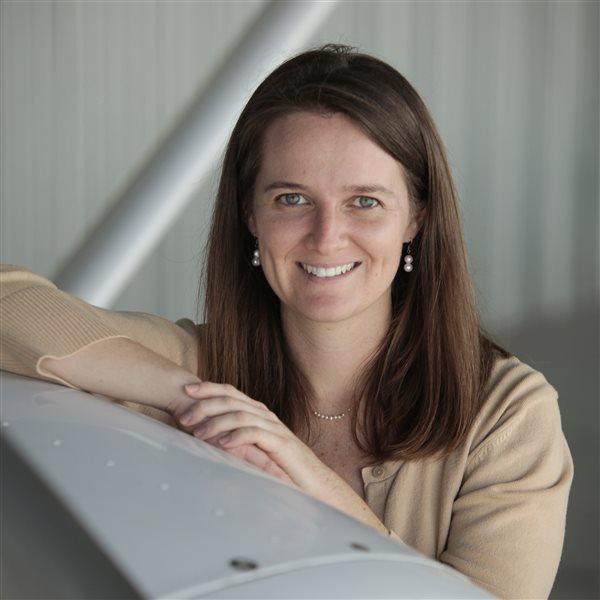'Sharing a brain cell'
<BR cmid="Article:Two Deck"><SPAN class=twodeck cmid="Article:Two Deck">Instructor, student overcome communication barrier</SPAN>
Chu Lee is fully deaf. He doesn’t read lips. His flight instructor, Dominick Moyer, doesn’t know sign language. But the two have a natural communication style that allows them to work together seemingly effortlessly in the cockpit. A quick thumbs-up, a nod, a note, or a finger point translates flawlessly into a takeoff, heading change, slip, or other maneuver.
“We have a system, like a body language system, and when he makes a certain movement, I know how to adjust. It’s like we’re sharing a brain cell on that one. We can really read each other’s minds,” Lee said through an interpreter. Lee, who was first captivated by aviation as a child watching military aircraft fly over Busan, South Korea, moved to the United States in 1987 to attend college and now lives in Odenton, Md.
The pair’s ease of communication was evident on a 45-minute cross-country flight from Frederick, Md., to Cumberland, Md., on a clear VFR day. Lee frequently ran his hand across the windscreen, letting Moyer know that he was scanning for traffic. Moyer quizzed Lee on his visual checkpoints and time calculations by pointing at the sectional chart and jotting notes.
Hand signals increased as they began their descent and approach at both nontowered airports. (Moyer handled the radio communications.) On the return to Frederick, Moyer used hand signals to instruct Lee to slip to lose some altitude on final—a signal that Lee instantaneously understood and complied with, but this passenger misinterpreted as a call for S-turns.
After the flight, the two communicated using Moyer’s laptop. “Good job today,” lined the top of the debrief Word document. Moyer often sends the debrief notes to Lee via e-mail so that he can study them between lessons.
Immediate connection
Communication came naturally for the two when they started flying together earlier this year through Frederick Flight Center at Frederick Municipal Airport.
 Frederick Flight Center instructor Dominick Moyer (left) and Chu Lee after completing a cross-country flight from Frederick, Md., to Cumberland, Md.
Frederick Flight Center instructor Dominick Moyer (left) and Chu Lee after completing a cross-country flight from Frederick, Md., to Cumberland, Md.
It helps to have “a good understanding of what each other wants, and I think we had that from the start,” Moyer said of Lee, his first student. Lee had worked with another instructor in 2008, which helped to ease Moyer’s transition into the world of flight instructing—he already grasped takeoffs, landings, and the basic flight maneuvers. Moyer has helped Lee hone his skills and taught him some new techniques, including the wing-low method for crosswind landings because Lee knew the crab method.
“He explains everything very clearly so that I understand,” Lee said.
Moyer said he had complete confidence signing Lee off for his solo flights. Just as many student pilots say they hear their instructor coaching them during their first solo or solo cross-country, Lee said he often imagines Moyer is right there with him, guiding him along the way with nonverbal cues.
While most of Lee’s flight training has taken place at nontowered airports, the two are planning a flight to a towered facility for him to practice receiving light-gun signals—all in preparation for Lee’s upcoming checkride.
“I have a lot of faith that he’s going to do well on this,” Moyer said.
Ultimate dream
 Chu Lee is working toward his private pilot certificate and hopes to one day fly Boeing 747s or 777s.
Chu Lee is working toward his private pilot certificate and hopes to one day fly Boeing 747s or 777s.
Lee’s motivation during the private pilot flight training is his ultimate dream: to fly a Boeing 747 or 777. He’s already had two opportunities to observe flight crews performing their duties in flight in each—something he encouraged his flight instructor to check into after Moyer joked that he’s only been able to ride as a passenger in the back of those mammoth passenger jets.
According to Lee, the crews from both jets said he should be able to fly the aircraft for a career despite being deaf. “But I said, ‘How can I communicate on the radio?’ And they said, no, there are other backup options. You have to be ready. The main thing is that you have to be paying attention, and it can be handled smoothly,” Lee said, explaining that they communicated in the cockpit through writing. “They said yes, I can do it. Deaf people can do it.”



